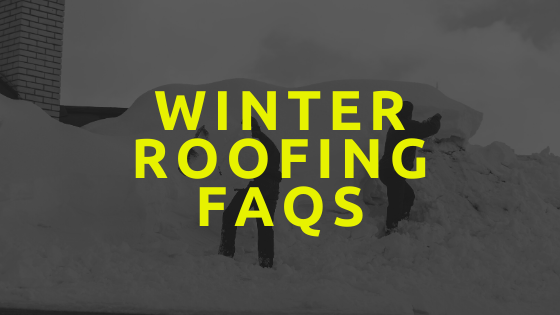Winter Roofing FAQs

Winter roofing is not very common and some people winder if it is right to replace or repair their roofs during this season or not. In this article you are going to learn a lot about winter roofing and by the time you are done you will be able to make an informed decision about whether winter roofing is right for you. We look at some of the most commonly asked questions about winter roofing and provide you with professional answers based on our experience.
1. Is it okay to do roofing in the winter
Yes! There is no problem with winter roofing as long as it is done by a professional roofer who have been in the game for quite some time. And most importantly one who has experience in roofing during the cold seasons.
However, it is not the perfect time for roofing as it comes along with some risks like tripping off from the roof due to the ice and snow, leading to serious injuries. The asphalt shingles which are the most common across Canada can be very tricky to install during the winter because of the adhesives.
But sometimes you really don’t have any other option and you have to repair your roof during the winter and that’s where we come in. Our team is made up of professionals who have been doing winter roofing for years and we have all the equipment and tools needed to accomplish the project perfectly.
2. Should a contractor remove the debris from the roof or should the homeowner include that as a part of maintenance
During the accomplishment of the project, if there are twigs, leaves and debris the contractor will obviously remove them. But that does not mean that that’s their duty, you should include removal of twigs and debris as a part of your regular maintenance of the roof. After all, you are responsible for roof maintenance of your roof.
However, there are some roof cleaning tasks that goes beyond the capability of the homeowner and any attempt to clean the places can prove to be dangerous to the homeowner. And if not dangerous to the homeowner, it can lead to damage of the roof.
Working on your roof from the ladder can be very dangerous especially for people who lack the physical ability, skills and knowledge to do it right. It will be for your best interest if you hire an expert to help you out. And it is very important to make sure you hire a real expert not just another guy claiming to be an expert. One who does not know the right procedure, it will be dangerous for him and it will lead to haste work and the work completed will not be of the quality you expected.
Check carefully the type of cleaning the hired roofer is using because some aggressive measures like use of stiff brooms can end up damaging the shingles and removing the protective granules and hence reducing the lifespan of the roof.
3. How can a homeowner know if the shingles are newer and if the growth of algae is a risk
Check if they are algae resistant or if there were algae resistant covering materials used. Most manufacturers normally indicate if the shingles are algae resistant on the package or in the product literature.
An algae resistant roof does not mean it is algae proof. It is still very possible to spot algae growth even on roofs where algae resistant roof was installed.
There different factors that leads to growth of algae such as under ventilation. If the slope areas of the roof is exposed to shade vs sun it may lead to growth of algae on your roof. Leaving debris, twigs and leaves will leave your roof surface damp and shaded and hence encouraging the growth of the algae.
There just many different reasons which can lead to growth of algae on your roof and installing an algae resistant roof does not mean your roof will never grow algae ever. You just need to take care of your roof the proper way and everything is going to be alright.
4. What happens if the old flashing is not replaced with a new flashing during a roof replacement
That will depend on the old roof but generally it increases the risk of leakages. Heavy flashing that is made of high quality material like for example copper, might just be left but it will depend on the location it is being left. For example the roof sidewalls and chimneys. In areas like that they can be integrated nicely with the new shingles that are being installed and be reused.
As for other roof flashing such as valleys and plumbing vents may not integrate properly with the surface of the new roof. If the old roof flashing is corroded, worn, thin, cracked, and in any way, damaged, then it should not be relied upon. Such a flashing needs to be replaced completely.
5. What are the advantages of winter roofing
Even though winter roofing can be risky and dangerous especially to the unskilled and amateurs, it still have some advantages. One of the main advantage is the fact that winter is an off peak season for the roofing contractors so you can be sure of getting quotes from different contractors and going for the best deal. Another advantage is that your roof may be replaced within the shortest time possible since the roofing contractors will be having a less busy schedule.

In Awe Roofing Limited is an Award-Winning, family owned and operated Vancouver Roofing Contractor with over 17 years of roofing experience. We serve the entire Lower Mainland area, from Whistler to Chilliwack, employing a team of professional staff members. Our team has won numerous awards including Best of Homestars for the last five years, and Three Best Rated six years in a row. Learn more






















